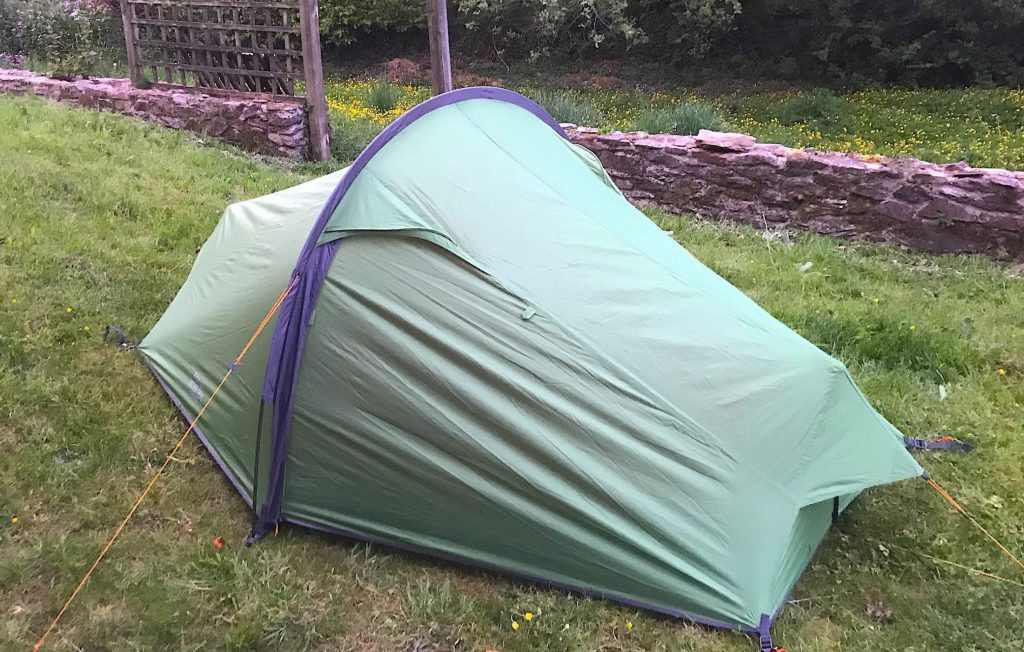
The Vango Nevis 200 is my current favourite tent, because it strikes a balance between cost and weight, and is excellent quality. It is a part of Vango’s Experience range of modestly priced, but still very good tents.
The Bottom Line
 (4 / 5)
(4 / 5)
- Sleeps 1 comfortably (not really a 2-person tent)
- Very light given the price (1.8kg ‘trail weight,’ 2kg in reality)
- Very reasonably priced
- Not the easiest pitch, requires fairly flat ground to go up nicely
- ‘Fastpack’ bag – allows you to pack it better than factory
Purchasing
The Vango Nevis 200 is extremely easy to get hold of. It is available on Amazon, and also direct from Vango – and pretty well any other UK outdoor retailer. It is also fairly cheap: its RRP is around £100, but you can usually get it for £60-70. If you’re willing to go used, of course, it is even cheaper.
Included
The Nevis comes with only a minimum of accessories:
- Outer rain fly
- Inner tent
- 3 Aluminium poles
- 10 tent pegs
- 3 Bags – for poles, pegs and the tent itself
- Mini tent repair kit
Pitching & Packing
This tent is not the easiest in the world to pitch. You have to get everything right from the very start, otherwise there will be tension in odd places and the tent will flap about in wind. Not only is this annoying at night, but it also puts stress on the tent and can break it. It also increases the chances of you getting wet. This is definitely a tent to practice pitching at home. Pitching is easy once mastered, but you need to make sure you practice.
Thanks to the ‘Fastpack’ bag, packing this tent really couldn’t be easier. You can just take the pegs and poles out, suff it in the bag, tighten the straps and you’re done. But taking that approach destroys the tent fairly quickly. I always separate the inner and the outer (because otherwise water on the outer seeps though and leaves you with a wet inner, see our tent tips). Doing this also makes it fit into my pack much better – when on trips, I don’t take the main bag.
Once separated, I fold both parts down to the width of their bag and then roll them together. I put the poles and pegs in the middle of the roll. This lets me pack the tent considerably better (and smaller) than it was packed when it arrived, straight from the factory. Because the bag is ‘Fastpack,’ it isn’t a fixed size – so I can make the bag smaller if I manage to pack the tent smaller, which is great.
Space
As I mentioned, this isn’t really a 2-person tent. I can just get all my gear (without boots) inside alongside my roll mat – but even that is a bit of a squeeze.
One of the main reasons I chose this tent (and, more generally, this shape) is because it gives a lot of headroom. I can sit bolt upright inside this tent very easily – unusual, considering I’m 6’2″. When buying, I also looked at the Wild Country Zephyros 2 – which is basically the same tent – but I went for this because of price.
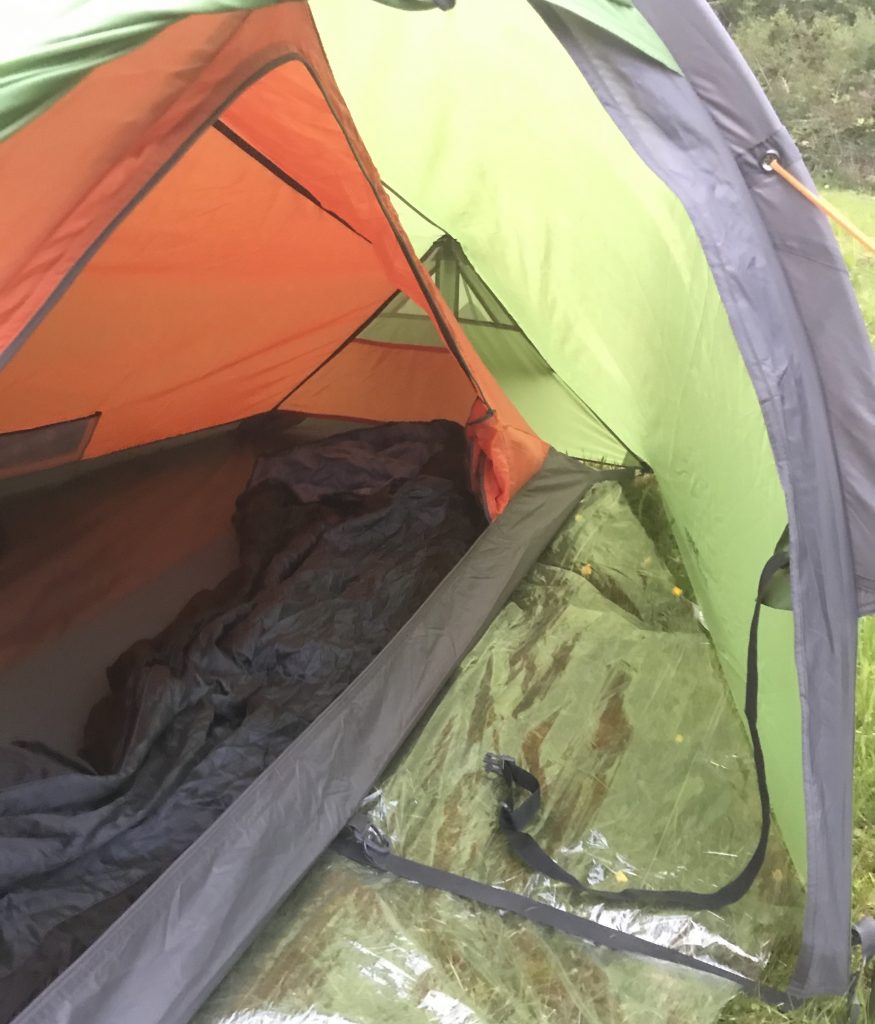
Another massive pro of this design is its porch (or ‘vestibule’ or ‘foyer’….), which is very large, especially compared to Vango’s Banshees (see our review). It runs the length of the tent and is great for storing even very large packs – and I tend to make my breakfast in it.
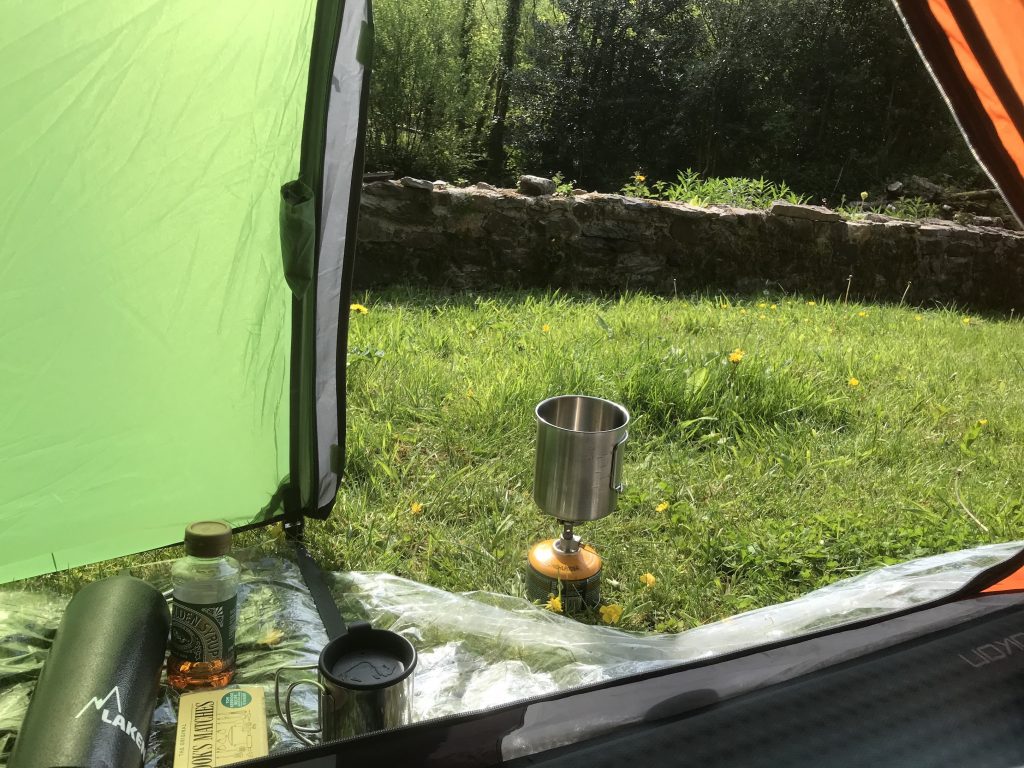
As you can see in the picture, having such a large vestibule may mean you want a waterproof groundsheet. This will keep your gear off the wet grass. Vango do sell a footprint for this tent, but if you don’t need the weight – or if you don’t need the whole area – then it can be much better to go with something lighter. I recommend polycryo – a cheap (window-glazing) film that is really tough and great as a groundsheet which you can cut to size.
Quality
As with many Vango products, it is hard to find many faults with this tent’s quality. It is well made and clearly built to last. The stitching holds well and all the seams are sturdily taped – except for one. My tent arrived slightly leaky at the top of the vestibule door, so I bought some seam-sealer and it now works fine. The pegs that come with this tent are also very sturdy, although won’t hold in sandier ground. The aluminium alloy poles are tough yet flexible, and on top of all this, Vango includes a repair kit in the package. The repair kit contains an extra piece of all the fabrics used in this tent (but nothing to attach them with) and a pole sleeve to fix a broken pole. One is ample because, unless you’re really doing something wrong, the two shorter end-poles really shouldn’t break.
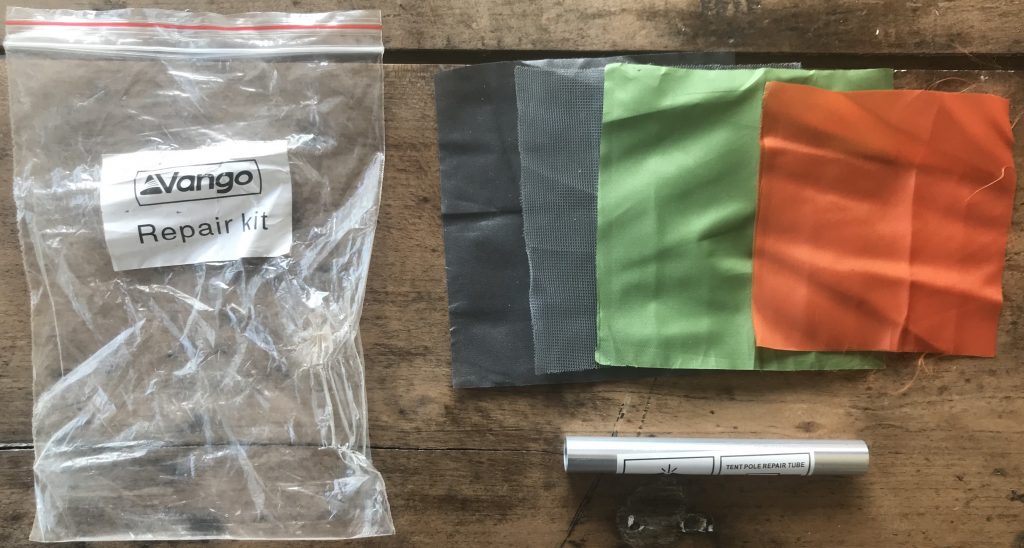
Issues
The Vango Nevis is good, but not quite perfect. I have found a few issues with it:
1. Zips
Unlike most tents, the Nevis’ zips only have one zip-pull, which means that you can only open and close the doors in one direction, from the bottom. It is especially annoying with the ventilation flaps at the tops of the outer doors. Because there is only one zip-pull, you can’t actually open the ventilation flap at the top – only from the bottom. And this opens the entire door. Because of this, there is more condensation than necessary on the inside – it’s impossible to ventilate.

2. Tension Band
This tent is fitted with Vango’s Tension Band System, which helps to get a sturdier pitch and makes the tent hold up to weather better. But the bands pass through the inner’s door, so if you want to fully open the door you have to unclip the band and feed it out through a little slot in the door. In good weather, there is no need to use the band at all, but it’s still an inconvenience.
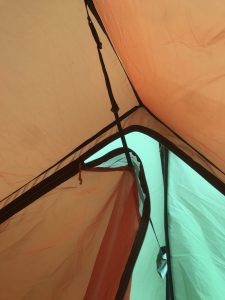
3. Ventilation
Because of the issue I mentioned with the zips, this tent is fairly badly ventilated. It has two small mesh sections at each end of the rain fly, under the sticking out parts, but that’s it. The side ventilation flaps at the top of the doors are, as I mentioned, impossible to use because of the zip issue. Obviously, if it isn’t raining you can just leave one of the outer doors open – but the tent even has the special flaps to protect the ventilation holes, and no ventilation holes to protect. As a result, the tent is quite condensation-heavy, although I’ve found that using a footprint (or just a piece of polycryo) does cut down on condensation.
Other Options
I didn’t know about these three issues when I was buying the tent, but I don’t see them as a deal breaker. The zips issue is a big inconvenience, but the tension bands don’t really bother me at all. If this is a big issue for you, I would recommend the Vango Cairngorm 200 – exactly the same tent with slightly sturdier fabric, stronger poles and 2-way zips. Of course, this is reflected in the price tag. The Cairngorm does tend to be a bit more expensive – but only by about £20-£30. We have a full comparison between the Nevis and Cairngorm here.
Tents aren’t the only option for shelter when camping. If you’re interested in buying some new camping shelter, why not check out our guide for choosing between a tarp and a tent here – a tarp can save you a lot of weight and money. If you’re set on a tent, have a look at our comparison of the Nevis and Vango’s Banshee range here, or, as mentioned, between the Nevis and Cairngorm here.

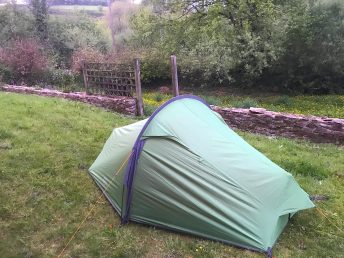
Agree re doors. Need two way zips!
Absolutely. Annoying because the Vango Cairngorm 200 has them, and for only a few £ extra.
Agree about the ventilation.
I can’t get my inner tent taut at all. Vango have said it’s a tension issue but there is no way to tighten the inner as far as I can see.
Yeah, the ventilation is a pity. Otherwise I think it would be one of the best tents!
Thats interesting with the inner, I’ve not had that problem. Which part of it is loose, is it the groundsheet itself or the ‘walls?’
Hi I also cannot get the inner tent taut and again Vango have told me it is a tension issue and I can’t see any way to tighten the inner.
Hi Caroline, Which part of the inner is it that is loose? I’ve found that if I don’t get the pegs for the corners in the right place the inner will never tension – and as you say there is no direct way to tighten it.
Yes I have this issue too.
No way to tension it and it sags a lot.
Not impressed.
I have had Vango 200 for about four years, and have the same impression. Weak ventilation. I have no idea why there is no vent holes at top of flysheet (for ex under door’s roofs).
Condensation is a second name of this tent.
Pegs are weak in soft ground – like a sand. To make a proper pitching on beach, additional BIG pegs required (its called snow-sand pegs).
But this tent have few huge advantages:
– relatively cheap
– easy to pitch even in rain
– lot of places inside for one person (there is even place for inflatable kayak inside)
– lightweight and small when packed.
– suprisingly wind-resist
My wife and I, both new to camping and wild camping, found this tent (We have the Nevis 300) to be really good. From a noob perspective, it was the right balance between price, weight and features compared to other tents around the similar £100 price bracket. Agree with all the cons the article has explained. We’ve not experienced ventilation problems but have only used the tent in forecasted good weather.
I will add, that I found one of the 2 smaller pole fittings to be difficult to the point it feels like I’m breaking the fabric just to get it in. The 300 is perfect for 2 people with enough room to store items inside the tent. Setting up and packing are extremely easy. I’m sure as I experience more of the British weather I’ll find some more things that could be better.
Good review thanks. Regarding your waterproof groundsheet in the vestibule, do you have it pegged down or what stops it flapping with wind?
Hi Johnny, I dont find I need to peg it down at all, when I put my stuff on it it tends to stay put.
Thumbs up emoji.
One of the main aspects I like about this tent is that the outer flysheet is polyester. I have the Vango Helium UL2, similar shape, but nylon flysheet. When wet, the nylon sags and flaps and packs like cling film, trapping air. Polyester seems to dry more quickly and retains its shape in the cold and wet. Just a bit heavier though. I also have the Vango Tryfan 200, polyester flyssheet which is virtually a low level 4 season tent. The ventilation in this is very good.